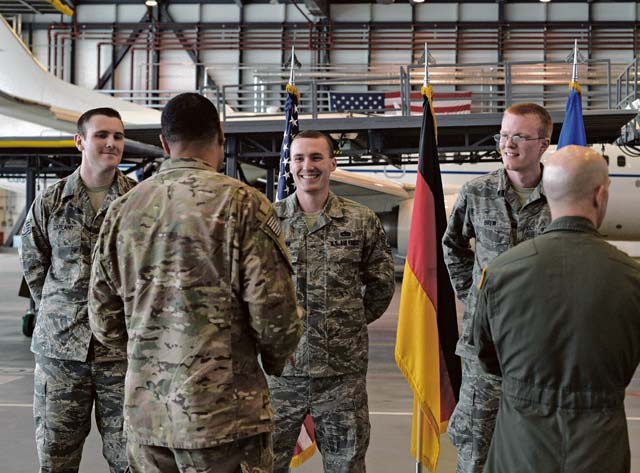
Airmen talk after a coin ceremony Aug. 10, 2016, on Ramstein Air Base. Master Sgt. James McConaghay, U.S. Air Forces in Europe directorate contingency manager, Tech Sgt. David Hobeck, 86th Maintenance Squadron unit deployment manager, Tech Sgt. Austin Schierberg, 86th MXS repair and reclamation craftsman, Staff Sgt. Cory Garland, 86th MXS repair and reclamation journeyman and Staff Sgt. Geoffrey Brew, 86th MXS UDM, were recognized for successful completion of an aircraft recovery mission.
Col. Robert Orris, Joint Special Operations Air Component commander-Africa, coined Ramstein Airmen for completing a recent aircraft crash recovery mission, Aug. 10.
Five 86th Airlift Wing Airmen collaborated with battlefield Airmen, Navy seabees, Army and Air Force special forces and local nationals on a short-notice mission to recover a C-146A Wolfhound after the right main landing gear became stuck in a remote location’s soft sand.
Master Sgt. James McConaghay, U.S. Air Forces in Europe directorate contingency manager, Tech Sgt. David Hobeck, 86th Maintenance Squadron unit deployment manager, Tech Sgt. Austin Schierberg, 86th MXS repair and reclamation craftsman, Staff Sgt. Cory Garland, 86th MXS repair and reclamation journeyman and Staff Sgt. Geoffrey Brew, 86th MXS UDM were the five Airmen recognized.
Their efforts in communicating between joint forces, equipping for the mission and completing a significant short notice tasking led to Orris commending the Airmen on a job well done.
“The speed you (completed the mission) was remarkable to us,” Orris said. “It was truly a joint and combined effort.”
According to Orris, a wide variety of Airmen and individuals played a role in assisting with the aircraft retrieval.
Schierberg and Garland led the ground team as the Crash Disabled Damage Aircraft Recovery team dispatched.
“The location’s terrain was very difficult (to work with),” Garland said. “Working with (limited equipment) was definitely challenging”. “We were limited to what we could bring and we had to make do with what we had.”
Although their CDDAR course supplied Garland and Schierberg with the knowledge to make repairs in similar situations, the isolated location’s few resources required them to take their skills to a completely different level.
“The beginning was the most challenging,” Schierberg said. “Every time we would dig, more (sand) would fall in the hole. It was hard to compact it and keep it at bay. It was kind of deterring. We’d dig and dig, then the aircraft would shift. It felt like we were going nowhere.”
The burning heat and inclement weather also proved difficult, but the Airmen persevered.
“It rained on us one of our nights and set us back a little bit. We were able to bounce back from (the setback) and surprisingly the day after it rained (was) our most successful day.”
The success was shared by some towing help from local nationals.
“One of the locals had a three-axle truck,” Schierberg said. “It was monstrous. It was probably bigger than the aircraft. We hooked it up with some tow slings and pulled (the aircraft) out like a champ. It came out exactly like we wanted it to.”
Schierberg said the recovery went excellently.
In the end, by utilizing their training capabilities the team’s effort led to a fully operational aircraft.
“I’m glad I had the opportunity to be a part of the actual mission and (gain) first-hand experience,” Garland said. “It was really cool experience, and I definitely learned a lot.”


